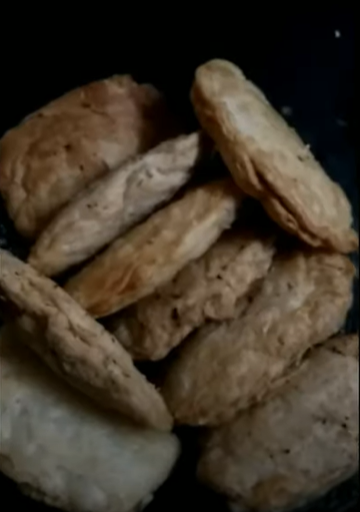Pudachi Karanji recipe is the Maharashtrian show-stopper you make when you want layers that shatter and a sweet coconut-khus khus hug inside. This post follows the method from our YouTube video and adapts it into an easy, print-friendly guide for your kitchen.
Flaky “pudar/पुड” (layers) on the outside, softly sweet coconut on the inside, and a crunch that says khus-khushit with every bite. The layered gujiya technique is classic—and we’ll keep it simple and home-friendly here.
Ingredients for Pudachi Karanji Recipe
Dough (cover)
- Maida (all-purpose flour) – 2 cups (≈250 g)
- Fine rava/sooji – 2 Tbsp
- Salt – ¼ tsp
- Hot ghee – 3 Tbsp (for moyan)
- Water – as needed for a medium-firm dough
Sata (layering paste)
- Soft ghee – 3 Tbsp
- Cornflour or rice flour – 3 Tbsp (mix to a smooth, spreadable paste)
Sweet coconut filling
- Desiccated/dry grated coconut – 1½ cups
- Poppy seeds (khus khus) – 2 Tbsp, lightly roasted
- White sesame (til) – 1 Tbsp, lightly roasted
- Powdered sugar – ½ cup (adjust to taste)
- Fine rava/sooji – 1–2 Tbsp, lightly roasted
- Cardamom powder – ½ tsp
- Chopped cashews & raisins – 2–3 Tbsp (optional)
- Ghee – 1 tsp (to sauté nuts)
Oil or ghee for deep-frying
Step-by-step Pudachi Karanji recipe
Step 1 -Make the dough
In a bowl, mix maida, rava, and salt. Add hot ghee; rub till sandy. Gradually add water and knead to a smooth, medium-firm dough. Cover and rest 20–30 minutes.
Step 2 – Prepare the filling
Warm 1 tsp ghee; sauté nuts and raisins till fragrant. Add coconut, poppy and sesame; roast on low until aromatic. Cool fully, then mix in powdered sugar, cardamom and rava.
Step 3 – Roll, layer, shape & fry
- Layering: Firstly, divide dough into 3 balls. After that roll each into a thin disc. Now brush sata over disc 1, stack disc 2, brush sata, top with disc 3. Roll the stack into a tight log (like a Swiss roll). Meanwhile, rest/chill 10 minutes for clean cuts.
- Cut & roll: Secondly, slice the log into ¾-inch rounds. With the spiral facing up, roll each into a small oval/circle.
- Fill & seal: After that place 1–1½ Tbsp filling on one half, then dab edges with water, fold to a semicircle, and crimp (hand pleats or fork).
- Fry: Finally, heat oil/ghee medium low. Fry 3–4 at a time, basting on and off, till puffed and pale-gold. Drain on a rack.
Pro tips & quick fixes – Pudachi Karanji Recipe
- Crisp layers: Keep heat medium-low and be patient. Too hot = browned outside, raw layers inside.
- No leaks: Don’t over-fill; seal with water and press firmly.
- Visible flakes: Thin, even sata + tight rolling = dramatic flakes.
- Sugar swap: Jaggery works; just cool roasted coconut before mixing, so it doesn’t melt early.
Serving suggestions (with internal links)
- Plate with Shakarpara and Chirote (Pakatle Chirote) for an Insta-worthy Diwali mithai thali.
- Dust some karanjis with powdered sugar and leave others plain for texture contrast.
- Serve warm with masala chai—or go luxe with a drizzle of warm rabdi.
Storage, reheating & shelf life
- Room temp: Once fully cool, store airtight (steel/glass). Stays crisp 7–10 days in a cool, dry spot.
- Reheat: Air-fryer 150°C for 3–4 minutes or oven 150°C for 5–6 minutes to refresh crispness.
- Freeze (short-term): Shape but don’t fry. Freeze in a single layer, then bag. Fry from frozen on medium-low heat.
Variations of Pudachi Karanji recipe
- Mawa gujiya style: Add ½ cup crumbled mawa to the cooled filling for richer karanjis.
- Jaggery & coconut: Replace sugar with grated jaggery; season with nutmeg and cardamom.
- Savory Vidarbha twist: Try coriander-coconut-peanut-chilli filling (reduce sugar to a pinch).
Nutrition (per piece, approx.)
- Calories: ~180 kcal
- Carbs: ~20 g | Fat: ~10 g | Protein: ~3 g
- Contains gluten, dairy, nuts. Values vary by size and oil absorption. (Coconut adds fiber and healthy fats; poppy/sesame add minerals like calcium and magnesium.) Swasthi’s Recipes, Hebbar’s Kitchen
FAQs
- Why did my layers not open? Sata too thick, rolling too tight/uneven, or oil too hot.
Why is my crust chewy? Dough too soft or fried on high heat—aim for medium-low and slow.
Can I bake? Yes; brush with ghee and bake at 180°C for ~18–20 minutes, flipping once (texture will be different).
Outbound references (for curious cooks)
- Health benefits & festive ideas: Indian Healthy Recipes — Diwali Snacks. Swasthi’s Recipes
- Classic karanji basics & ratios: Hebbar’s Kitchen — Karanji. Hebbar’s Kitchen
Final thoughts (Conclusion)
Make this Pudachi Karanji recipe once and it’ll become your Diwali signature—light, flaky and khus-khushit to the core. Try this at home and share your feedback in the comments; tag us on Instagram and subscribe to our YouTube for more festive treats!
Subscribe to BestCookShobha YouTube channel for more authentic Indian recipes and cooking tips!

